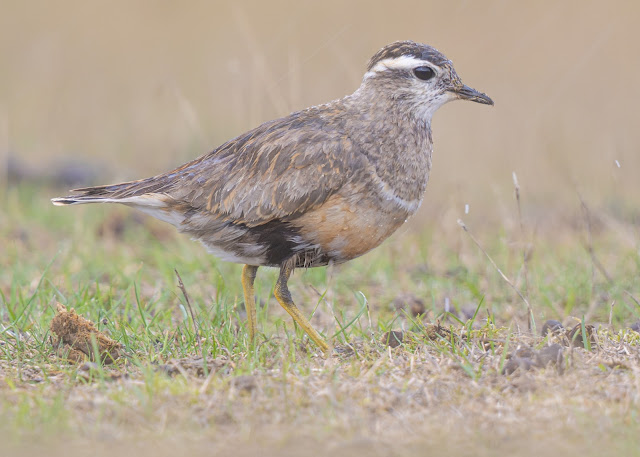The Dotterel is less than an annual bird for me. In fact that last Dotterel I saw was in the Spring of 2019 on a trip to the Outer Hebrides with Jeremy. So when two particularly confiding individuals were found on Cleeve Common just 20 or so miles from home visiting them was a no-brainer.
The Dotterel breeds in the Arctic tundra from Norway to eastern Siberia. Small numbers also breed on the Scottish mountains and the first ones I ever saw a number of years ago were on a trip to the Cairngorms with Jeremy. They are strongly migratory wintering from Morocco eastwards to Iran. Small numbers are seen in England during their autumn migration, usually on grassy hill tops.
They are attractive brown and black streaked birds with a broad white eye-stripe and an orange-red chest band when in breeding plumage. The bird is tame and unsuspecting and the term "dotterel" has, apparently, been applied contemptuously to mean an old fool!! The English name is said to date from the 15th century and was used as an insult for someone considered simple or a dotard.
The normal breeding roles are reversed in Dotterels. The female is the more brightly coloured bird and plays no part in brooding the eggs or raising the chicks. She has long since gone off to find another male and lay another clutch of eggs!
The given location of the Cleve Common birds was near the so called memorial tree equidistant and some 30 minutes’ walk from the two possible car parks at the masts and the golf club. The map reference from RBA was loaded into my OS Locate app showing the birds on one of the golf course fairways, should be interesting then if there were golfers around!
I was greeted at the masts carpark by a particularly ominous looking sky and so donned my waterproofs. Now Cleeve Common is not a good place to be during lightening but common sense was never one of my strong attributes so I set off towards the gold course. On the way I met a photographer who told me they he and his mates had failed to find the birds during an hour or so search, not very encouraging then!
The map reference took me to the edge of a fairway from where I spied a couple of birders clearly looking at the Dotterels some 50 meters away. To say they were confiding would be a massive understatement. I sat on the ground with my camera mounted low down on my tripod and they walked around me completely unperturbed by my presence. One was an adult the other was a juvenile, i.e hatched this spring. They were busy feeding on invertebrates in the soil recently loosened by the thunderstorms. A passing squall soaked the birds but they barely seemed to notice. The droplets of rain clinging to their feathers glistened when the sun appeared from behind the black clouds making these already very attractive birds even more photogenic. After rattling off much too many shots I went to check RBA on my phone but I didn’t have it. I had dropped it somewhere between the fairway and the birds location. The old fool had dropped his phone while watching the old fools!
 |
| Adult |
 |
| Juvenile |
Now you would think a red phone would be easy to find but I went up and down the route I had taken many times to no avail. I was joined by the other birders who also searched and rung my phone. In the end I drove back home, got the exact location from find my phone on another Mac device and went back. My friend from Oxford, Mark Chivers, was photographing the Dotterels so I checked if he had found a phone and then walked to the app location and found it straight away, I’m not sure how I missed it earlier to be honest as it was very obvious!







Comments
Post a Comment